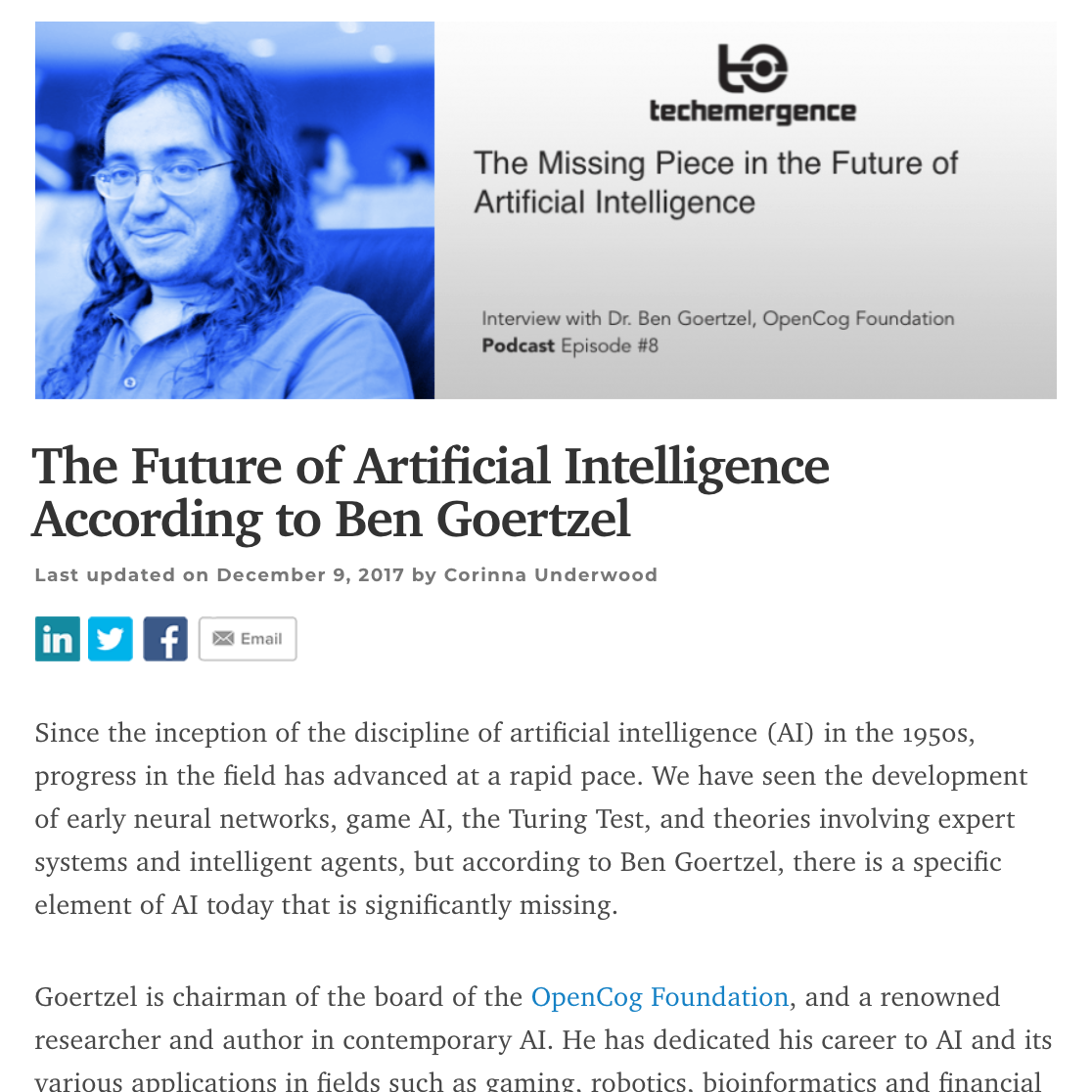
If you combine the hype-factor of both “blockchain” and “artificial intelligence” you often get a supernova of jargon. This week on the AI in Industry podcast, we aim to get beyond the hype to discuss how blockchain might make AI more accessible for small and mid-sized businesses in the years ahead. Dr. Ben Goertzel – CEO of SingularityNET – is our guest this week.

Guest: Dr. Ben Goertzel
Brief Recognition: Ben is currently the CEO of SingularityNET, an open source, blockchain-based network for finding, buying, and selling artificial intelligence applications. Ben is also Chairman of OpenCog and the Artificial General Intelligence Society, in addition to his position as Chief Scientist at Hanson Robotics. Dr. Goertzel studied mathematics at NYU, and received his PhD in mathematics from Temple University.
Current Affiliations: SingularityNET, OpenCog, Artificial General Intelligence Society, Hanson Robotics
It’s been five long years since my first interview with Ben – back when I had a personal blog and virtually no following at all, Ben took the time to dive into an hour-long conversation about his perspectives on how artificial general intelligence (AGI) may develop in the decades ahead (that past interview can be found here).
I appreciated that gesture way back when, and it’s interesting to see how some of Ben’s past ideas are being carried out in his latest endeavor. Goertzel, Hugo de Garis, and Nayef al Rodan could probably be counted as the writers who most influenced my ideas about AI ethics when I first came to adopt it as my purpose (Ben still writes some good material on his personal blog every now and again as well),
Three Factors That May “Democratize” Artificial Intelligence Through Blockchain
Our long-time readers know that our main goal with any of our interviews is to help AI executives (a) get an understanding of how AI is being used in industries today, and (b) to help executives “see around corners” and understand trends that might effect their industries.
The purpose of this interview is to shed light on how businesses will find and use AI in the future – and the role blockchain may play in facilitating the spread of AI (particularly into small and mid-size businesses who can’t afford to pay Accenture or hire a room full of PhDs from Carnegie Mellon).
The impact of blockchain on AI is admittedly foggy, and my goal with Ben was to paint a picture of what the possibility-space might be. My hope is that the interview will also help flesh out some of the pros and cons of blockchain-based systems, which will be seeing increased experimentation across industries in the five years ahead.
Below we’ll explore three of the factors that Ben believes could lead to a more democratized access to AI.
1 – Natural, Specific Search for AI Solutions
Ben spoke at length about one of the pivotal challenges in the AI space today: Search. Finding the right AI solution, knowing what solutions are “real” or just PR fluff, and knowing which solutions solve which AI problems – that’s all quite hard to do today.
There’s a lot more work to be done to make AI “searchable”, and Ben believes that natural language (written or spoken) would seem to be the ideal method for search. A few examples:
- “I need to summarize legal contracts to understand their most important clauses”
- “I need to label images and video clips from a set of vehicle-mounted cameras”
- “I have 10,000 apparel orders coming in per day and I’d like to better predict demand so that I can prepare my inventory accordingly”
In an ideal world, Ben believes that AI systems could be searched in this manner – and a variety of solutions could be found through natural language of this kind. This would prevent users from having to spend weeks painstakingly poking into a dozen AI offerings (or talking to a dozen sales teams about getting a free trial) to figure out which of them might suit their business needs.
Here at Emerj we sort AI product companies into discreet industry categories to make this easier for business readers – and we also simplify and organize a wide collection of AI case studies to help flesh out what software works and which AI solutions are delivering results in the real world.
2 – Universal APIs to Connect AI Applications
Finding AI solutions is one thing, but getting them to “work” through such a decentralized system is a challenge (and a broader topic, worthy of an article in and of itself).
A decentralized blockchain system might be able to provide a simple portal for artificial intelligence application access via connected APIs. While few companies are likely to give their applications up to a propriety platform run by a for-profit company, a decentralized platform might become a useful conduit to connecting AI users to AI applications.
The challenge here is in making it possible to hook up different AI systems using different kinds of code into a single decentralized system to handle such requests. To quote Ben:
It has to be as easy as connecting a website to a database or something. Not to need a PhD in AI, but to have basic programming skills. Really the standardization is the key part, and it’s tricky because you may have 10,000 pieces of code for assigning labels to images, and they might be read by different people all over the world using different algorithms.
But then you need a standard set of interfaces by which all these image labeling AI’s accept folders of images standardized and by which they output the labels for the images.
…This becomes a kind of democratic control problem.
Ben uses “democratic” because the system would be expected to evolve rapidly. Instead of having a single company set a single protocol, we’d expect a living” system to develop constantly along with new developments in technology, and the common use-cases being addressed by a community of users.
It’s unclear exactly how this would be done, and Ben seems to be quite frank about how robust this problem is. It does paint a unique vision of the potential value of the blockchain. Ideally, such a system of interoperable APIs wouldn’t just allow for a single program to be used, but for a whole network of AI systems to interact in order to deliver a result for a user. Ben puts it this way:
For example, if you have an AI that’s supposed to summarize a document for a user, if that AI finds a video in that document, it could outsource that work to a video summarization AI that is good at this different task. The AI’s could outsource work for each other… it’s an app store in which the apps could do work for each other, too.
I immediately thought that this sounded a lot like Marvin Minsky’s concept of the “society of mind” (from his 1986 book of the same title). Ben said that he prefers to analogy of an “economy” of minds, where interactions between components of an intelligent system can be quantified and possibly measured by merit.
Ben mentions that this kind of expanding potentiality might be a viable path to artificial general intelligence… but that would be another podcast altogether (one that I’d look forward to airing, frankly, as most of you know the “what’s after humans” question is more or less all I think about, and I’m surprised Ben and I didn’t go off on more tangents of that kind).

3 – Ratings and Scores Within an Ecosystem of Applications
In addition to AI systems being findable and useable through a decentralized hub, AI would also need to be ranked, rated, and scored based on their performance and ease of use. This kind of transparency would be among the most important factors in making AI more accessible.
AI systems could be rated across a number of criterion, arguably with the two most important being:
- How well the AI systems perform the specific task the user is looking to execute
- How easy the AI systems are to set up and use
With dynamics of this kind, people would have a better chance of finding and using systems to best suit their needs. In addition, it’s possible that companies would begin competing
We see similar dynamics in the world of WordPress Plugins, where usability and function are
I mentioned that this kind of a “living” system (where success is modeled, replicated, and iterated) seems to model nature, in a crude way. The analogy seems to be an apt one in Ben’s eyes, as he sees a blockchain AI system of this kind as a kind of emergent, living intelligence.
This is artificial life in some way… it’s a digital biological organism. It would consume resources and generate value for users.
Ben frames these connected ideas (in the concept for SingularityNET) as an alternative to an individual tech goliath owning the portal for AI access (as, say, Google has done for search) – and one could agree that at least having alternate routes to that situation (or to the current situation of fragmentation in the AI solutions market) could be fruitful.
It behooves all young companies to appeal the the noble endeavor of upsetting the unfair status quo – to fight “for the people” in making the system work for everyone, not just those at the top.
Robespierre and Bonaparte were the good guys before they reached the top, as were Uber and Facebook (who’s power and influence are being scrutinized heavily at the time of this writing) and revolutionaries tend to dislike revolution once they reach the top of the heap (i.e. When it behooves them). In the early days, “fighting the powers that be” tends to garner enthusiasm, and indeed startups (like revolutionaries) often marshall as much of this sentiment as they can.
I’ll make no moral statements about the approach to AI access that Goertzel paints (as I have none to make here), but it seems to be a viable option for solving some of the accessibility and cost problems of integrating AI, and it’ll be interesting to see how the future of AI and blockchain pans out. IBM appears to be in the running for an “platform” for building and finding bots (see their IBM Code Bot Asset Exchange), though the idea is quite new and seems more narrowly focused on chatbots, and on products built with IBM’s technology.
Hopefully the more good options out there to compete in the market, the more the best will win (much like the “ecosystem” point that Ben himself states above). May the best man-machine combination win.
If you’ve enjoyed this article and would like to stay ahead of the curve on the applications of AI in business, join over 40,000 other business leaders and follow our podcast on the platform of your choice:
Header image credit: Financial Times











